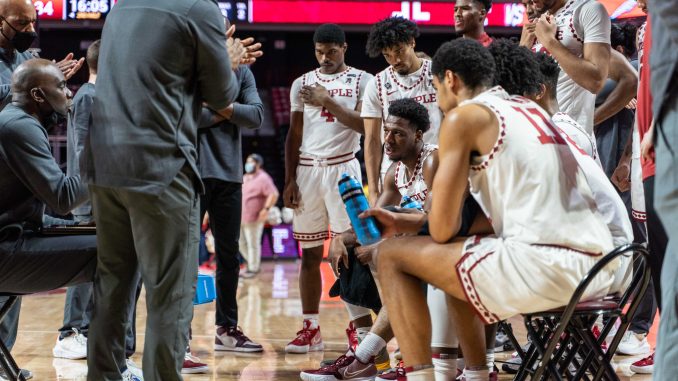
Temple University men’s basketball (7-5, 0-1 The American Athletic Conference) is still searching for consistent shooting efficiency and increased offensive production from their bench.
The Owls went on a five-game win streak from Nov. 21 through Dec. 7, defeating the likes of La Salle University (5-5, 0-0 The Atlantic-10 Conference) and Vanderbilt University (8-4, 0-0 The Southeastern Conference). Yet, just as their record hit 6-3, a visit to Saint Joseph’s University (6-5, 0-0 The Atlantic-10) sent the Owls on a two-game losing skid.
With sophomore guard Khalif Battle, who averaged 21.4 points per game, out for the season with a foot injury, the Owls experienced a number of new starters and rotation changes.
Temple is thriving in the paint thanks to their improved 3-point shooting, opening up easy looks at the basket. With Temple playing well inside, teams are unable to build big leads against the Owls.
Here are the key factors for the Owls so far.
Bench Potential
Early in the year, redshirt-sophomore guard Tai Strickland earned minutes due to his innate scoring ability, coming off the bench and creating his own shots to score in bunches.
Although his minutes have decreased after suffering an undisclosed injury, he was a key asset in the win against the Commodores on Dec. 7, putting up a career high of 21 points.
Head coach Aaron McKie has also given the true freshmen more minutes in hopes of generating an offensive spark.
Freshman forward Zach Hicks had a historic performance against Delaware State University (2-10, 0-0 The Mid-Eastern Atlantic Conference) on Dec. 22, where he scored a career high 35 points and 10 3-pointers.
“When teams go zone it opens the market for threes,” Hicks said after the game.
These moments gave the Owls momentum late in games, although the number of in-game lineup changes have, arguably, led to a lack of consistency on the floor.
McKie loves to utilize as many men as possible in each game, but as seen in losses to Saint Joseph’s and the University of Central Florida (8-2, 1-0 The American), it is the starters that dictate the quality of play.
Once the players on the floor were missing shots, it created a team-wide slump that led to steep deficits.
Lineup Changes
The Owls have tried several starting lineups this season – starting eight different players – and they have yet to find a concrete option.
There was stability across the floor in what seemed to be a solid lineup of redshirt-freshman guard Damian Dunn, freshman guard Jeremiah Williams, Battle, junior forward Jake Forrester and junior forward Sage Tolbert III.
And still, Battle’s injury opened up a plethora of opportunities for McKie.
At first, freshman guard Quincy Ademokoya started in Battle’s stead, but then freshman forward Nick Jourdain and freshman guard Jahlil White saw starting action.
“Our strength is in our numbers,” McKie said Dec. 5. “We have to do it by committee.”
If Temple hopes to have any chance at winning in the AAC, a solidified starting five and bench rotation will go a long way in finding consistent scoring and defensive options.
Paint Presence
All season long Temple has been a force down low.
As a team, the Owls rank 33rd in the country in blocks per game, and rank first in the AAC in rebounds per game, averaging 39.5 per game.
Temple has set the tone of most of their games in the paint, out-rebounding teams by a margin of more than three per game. There is not a main rebounder on the floor at all times for the team, though, as they hustle for boards as an entire unit.
“We attack the glass and take full advantage in the paint,” Forrester said.
Dunn and White are each averaging more than four rebounds a game, while the Owls have three forwards averaging more than four as well.
On the defensive end, the Owls are one of the best teams in the nation when it comes to protecting the rim.
Freshman forward Nick Jourdain is averaging 1.6 blocks per game, while Forrester is averaging just less than a single block per contest.
This coupled with the length of the guards makes their defense difficult for other teams to handle.
Williams and White have used their long arms and athleticism to prevent smaller guards from driving, forcing opponents to shoot contested jump shots.
Yet when opponents’ shots have been falling, a strong paint presence has done little to prevent blowout losses.
The Owls have the third-most losses in a conference where all but two teams sit above .500 so far. Temple comes out of the break with a tough schedule ahead, including next game against the University of Houston (11-2, 0-0 The American), so McKie’s squad will need to find consistency across the floor or else the season will quickly slip away.



Be the first to comment